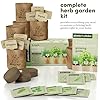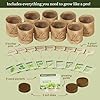SnugNiture 3 Pcs 2x2x1ft Round Galvanized Raised Garden Bed Kit Outdoor, Metal Planter Box for Planting Plants Vegetables, Brown
$56.99 (as of 13:54 GMT -05:00 - More infoProduct prices and availability are accurate as of the date/time indicated and are subject to change. Any price and availability information displayed on [relevant Amazon Site(s), as applicable] at the time of purchase will apply to the purchase of this product.)Best Choice Products Raised Garden Bed 48x24x32-inch Mobile Elevated Wood Planter w/Lockable Wheels, Storage Shelf, Protective Liner - Natural
23% OffComposting has become an increasingly popular topic in recent years, and it’s no wonder why. With more people becoming aware of the importance of sustainability, composting offers a simple yet effective solution to reducing waste and promoting eco-friendliness. In this blog post, we will explore everything you need to know about composting, including its benefits, how it works, tips for successful composting, common mistakes to avoid, and ultimately why it is the ultimate solution for sustainable living.
Introduction to Composting and Its Benefits
Composting is the process of breaking down organic matter such as food scraps, yard waste, and animal manure into nutrient-rich soil that can be used to fertilize plants. This natural process involves using microorganisms such as bacteria and fungi to break down the material over time until it becomes a rich, dark soil. The benefits of composting are numerous, including:
Reducing landfill waste: By composting your kitchen and garden waste, you can significantly reduce the amount of garbage that ends up in landfills, which helps to conserve valuable space and reduce greenhouse gas emissions.
Improving soil health: Compost adds essential nutrients to the soil, improves drainage and aeration, and encourages beneficial microbes that help plants grow strong and healthy.
Conserving water: Compost helps retain moisture in the soil, which means less water is needed to keep plants hydrated during dry spells.
The Science Behind Composting
At its core, composting is all about creating the right conditions for microorganisms to thrive. When you add organic materials to a compost pile or bin, they begin to decompose due to the action of microorganisms such as bacteria and fungi. These microorganisms require oxygen, water, and carbon-based food sources (such as leaves, grass clippings, and fruit and vegetable scraps) to survive and reproduce. As they consume the organic matter, they generate heat, which helps to kill off pathogens and speed up the decomposition process. Over time, the decomposing material breaks down into smaller pieces, eventually turning into a nutrient-rich soil that can be used to fertilize plants.
How to Get Started with Composting at Home
Getting started with composting at home is easier than you might think. Here are some steps to follow:
1. Choose a location: Look for a spot in your yard where you can place your compost bin or pile. It should be easily accessible but also out of the way so that it doesn’t interfere with other activities.
2. Collect organic materials: Gather together a mix of brown (dry) materials such as leaves, shredded paper, and cardboard, along with green (wet) materials like food scraps, grass clippings, and coffee grounds. You can also include animal manure if available.
3. Create layers: Build your compost pile or bin by layering the different types of materials. Start with a base of browns, followed by greens, then repeat until you reach the top. Each layer should be about 6 inches thick.
4. Water and turn: Keep your compost pile or bin moist but not too wet. Use a hose or bucket to sprinkle water on each layer as you build it. After a few days, give the pile a good stirring or turning to aerate it and encourage the growth of microorganisms.
5. Wait and watch: Composting takes time, so be patient! Depending on the size of your pile and the temperature inside, it could take anywhere from several weeks to several months before you have finished compost. Check on your pile regularly to make sure it’s getting enough air and water, and to identify any problems early on.
Tips for Successful Composting
Here are some tips to ensure successful composting:
1. Balance the ratio of browns to greens: Aim for a 3:1 ratio of browns to greens in your compost pile or bin. Too much green material can cause excess moisture and odors, while too little can slow down the decomposition process.
2. Turn your pile regularly: Turning your pile every week or two helps to aerate it and promote the growth of microorganisms. If you don’t want to do manual turning, consider investing in a tumbling composter instead.
3. Control the moisture level: Your compost pile should feel slightly damp to the touch, but not dripping wet. If it feels too dry, mist it lightly with a hose; if it feels too wet, add some extra browns to absorb the excess moisture.
4. Add diversity: Mix in a variety of materials to your compost pile or bin, including different types of plant matter, shredded paper, and even eggshells or citrus peels. This helps to provide a range of nutrients and attract different types of microorganisms.
Common Mistakes to Avoid when Composting
While composting is generally easy and low-maintenance, there are some common mistakes that can derail the process. Here are a few things to avoid:
1. Adding meat or dairy products: Meat and dairy products can attract rodents and create unpleasant odors, making them best avoided in composting.
2. Not adding enough browns: Without sufficient amounts of browns, your compost pile may become too soggy and smelly. Make sure to balance your greens with plenty of browns.
3. Not turning your pile: Failing to turn your pile regularly can lead to uneven decomposition and the buildup of unwanted gases. Try to turn your pile at least once per month.
Conclusion: Why Composting is the Ultimate Solution for Sustainable Living
As our world continues to face environmental challenges such as climate change and resource depletion, composting offers a simple yet powerful solution to reducing waste and promoting sustainability. By converting organic matter into nutrient-rich soil, composting provides a natural alternative to chemical fertilizers and reduces the amount of trash sent to landfills. Whether you’re looking to save money, reduce your carbon footprint, or support local agriculture, composting is a great choice for anyone interested in living a more sustainable lifestyle.
Related Content
- How to get rid of your Christmas tree in Philadelphia (the right way) – Axios
- 4 Winter Garden Tasks To Do NOW: Don’t Wait For Spring!
- Organic Gardening Advice To Make Your Garden Thrive
- Retaining Moisture in Dry Climates
- Public Notice of Metro Construction Projects Within Davidson County | Nashville.gov















































